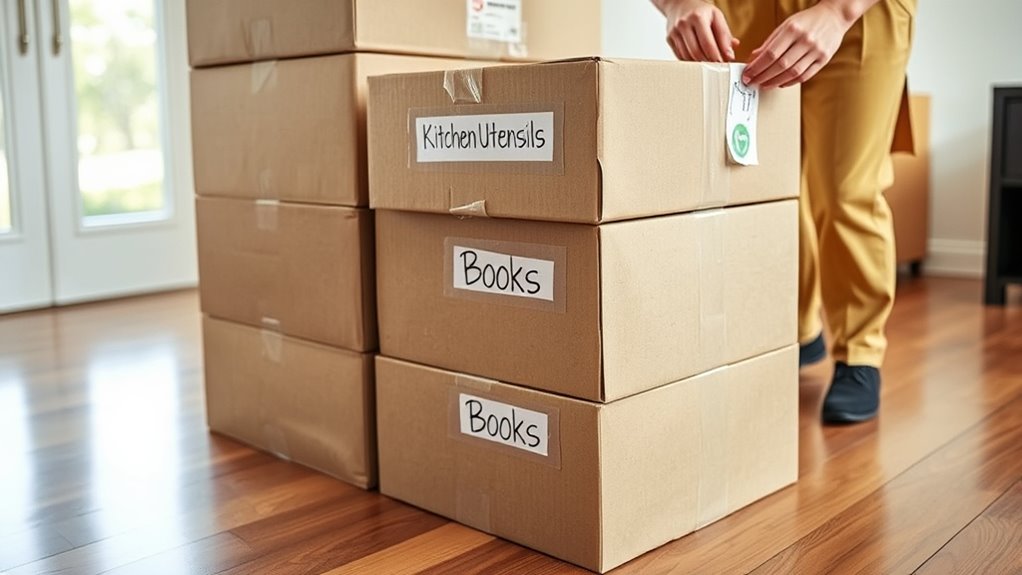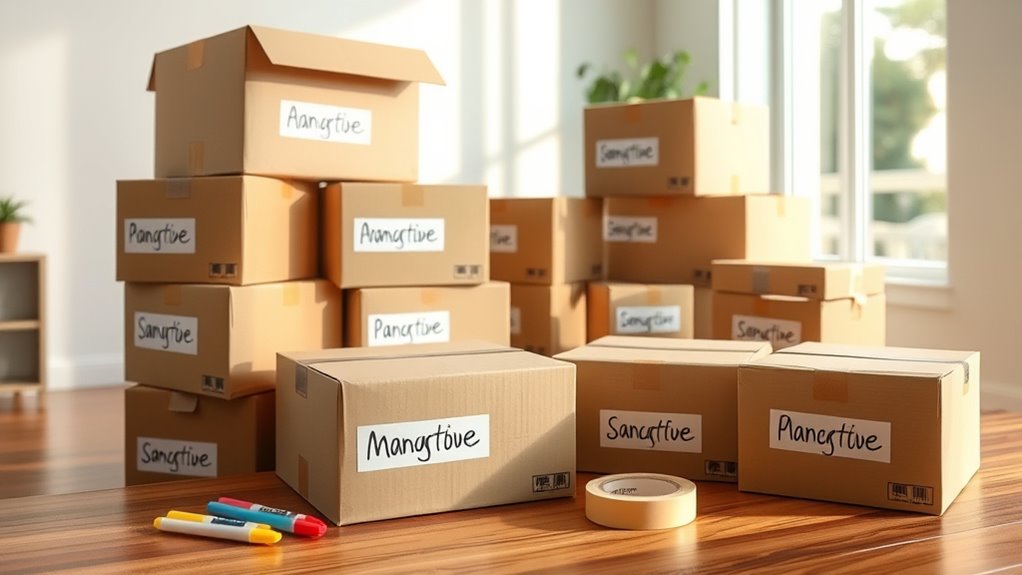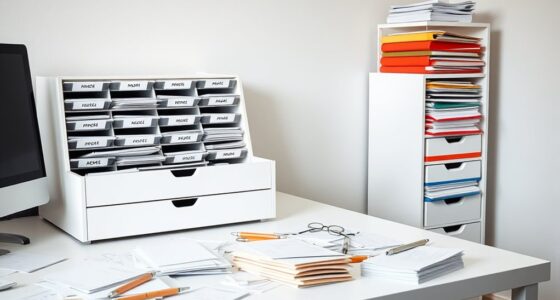To make unpacking stress-free, label your boxes clearly with their contents and intended room, using bold or colorful labels for easy identification. Write on all sides of each box, and consider color-coding by room to speed up the process. Be specific about fragile items and pack less-used belongings first. Double-check labels for clarity and security. Keep these tips in mind, and you’ll discover simple ways to organize your move seamlessly.
Key Takeaways
- Clearly label boxes with contents and designated rooms to streamline unpacking.
- Use color-coded labels for different rooms to facilitate quick identification.
- Label both the top and sides of boxes for visibility from multiple angles.
- Include handling instructions, such as “Fragile” or “Heavy,” on relevant boxes.
- Maintain a master list of box contents to track items and simplify organization.

Are you feeling overwhelmed by the idea of moving? It’s completely normal to feel a mix of excitement and stress when thinking about packing up your life and starting fresh somewhere new. One of the most effective ways to reduce that stress is by mastering the art of labeling your boxes. Proper labeling not only simplifies the unpacking process but also helps keep your belongings organized and protected during transit. The key is to be clear, consistent, and strategic about how you mark each box so you can find what you need quickly once you arrive.
Feeling overwhelmed by moving? Effective box labeling reduces stress, keeps belongings organized, and makes unpacking a breeze.
Start by labeling each box with its contents and the room it belongs to. For example, write “Kitchen – Pots and Pans” or “Bedroom – Clothes” on the top and sides of the box. This way, whether the boxes are stacked or stored in tight spaces, you can easily identify what’s inside without rummaging through every box. Use bold, legible handwriting or even color-coded labels for different rooms. For instance, blue for bedrooms, yellow for the kitchen, and green for the living room. Color-coding makes it visually obvious where each box belongs, saving time and effort during unpacking. If you want to go further, add a brief note about fragile items or special handling instructions, like “Fragile – Glassware” or “Heavy – Books.”
Invest in a set of sturdy, uniform boxes and label them consistently. Keep a master list of what’s in each box, either digitally or on paper, especially if you’re moving a lot of belongings. This list acts as a quick reference, making it easier to locate specific items later. As you pack, be systematic—start with less-used items and work your way toward essentials. When labeling, be specific enough to distinguish similar boxes; instead of just “Books,” specify “Children’s Books” or “Cookbooks.” This prevents confusion and makes unpacking more efficient. Additionally, understanding your personality traits can help you tailor your organization style to reduce stress during the move.
During the packing process, don’t forget to seal boxes tightly and use packing materials to prevent damage. Properly labeled boxes also help movers or helpers know which items are fragile or heavy, so they can handle them with care. As you finish each box, double-check that the labels are clear and secure. When unpacking at your new place, the labeled boxes will become your roadmap, guiding you straight to the essentials and reducing chaos. This simple step might seem small, but it’s a game-changer for staying organized, saving time, and making your move feel less stressful overall.
Frequently Asked Questions
How Should Fragile Items Be Labeled for Safety?
You should label fragile items clearly with “Fragile” and “Handle with Care” on multiple sides of the box. Use bright, noticeable markers or stickers to guarantee they stand out. Additionally, mark the boxes with arrows indicating which side should face up. This helps movers know how to handle them gently and prevents damage during transit, making your unpacking process smoother and safer.
What Color Codes Are Best for Different Rooms?
A stitch in time saves nine, so choosing the right color codes makes unpacking smoother. Use blue for bedrooms, green for the kitchen, yellow for the living room, and red for bathrooms. This system helps you quickly identify each box’s content and room. You’ll save time and avoid unnecessary confusion, turning a stressful move into a manageable task. Consistent color coding keeps everything organized and stress-free from start to finish.
How to Organize Labeled Boxes for Quick Access?
You should organize your labeled boxes by room and priority. Place the most essential boxes—like toiletries and kitchen basics—near the front or on top for quick access. Group similar items together, and stack boxes logically to save space. Use clear labels or color codes to identify contents at a glance. Keep a list of what’s in each box, and store them in a dedicated area for easy retrieval during unpacking.
Should Labels Include Specific Item Details or General Categories?
You should include specific item details on your labels rather than just general categories. This way, you can quickly identify exactly what’s inside each box without opening multiple containers. For example, write “Kitchen Utensils” or “Books – Science Fiction” instead of just “Kitchen” or “Books.” This saves you time and reduces frustration during unpacking, making the process smoother and more organized. Clear labels make unpacking less stressful overall.
What’s the Best Way to Remove Labels After Unpacking?
To remove labels after unpacking, gently peel them off if they’re paper-based, using your fingers or a plastic scraper to avoid damage. For stubborn adhesive, rub a bit of rubbing alcohol or warm soapy water on the label’s edges and wait a minute before peeling. You can also use a hairdryer on low heat to loosen adhesive. Always test a small area first to prevent damage.
Conclusion
Labeling your boxes isn’t just about organization—it’s your map through the chaos. Think of each box as a treasure chest, holding your future comfort and memories. When I moved last year, clear labels turned unpacking into a breeze, saving me hours of guesswork. With each label, you’re creating a smooth path to your new home. Trust me, a little prep now makes the whole journey feel like a walk in the park rather than a mountain climb.









